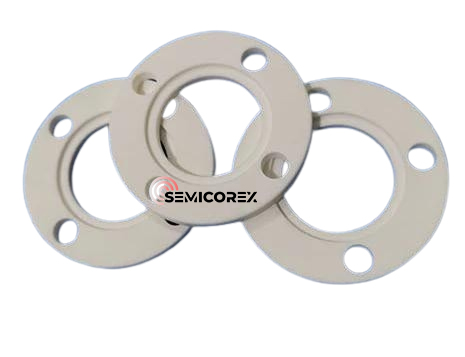Design and Applications of Alumina Ceramic Flanges
2024-07-12
Alumina ceramic flanges are specialized components used in high-temperature and corrosive environments where excellent thermal and mechanical properties are required. Here are the key aspects and characteristics of alumina ceramic flanges:
Material Properties
1. Alumina Ceramic
- Composition: Alumina ceramic is a high-purity, fine-grained material known for its exceptional mechanical strength, hardness, and thermal stability.
2. Chemical Resistance
- Corrosion Resistance: Resistant to most acids, alkalis, and chemicals, making it suitable for harsh chemical environments where metallic materials may corrode.
- Inertness: Chemically inert nature ensures compatibility with various substances and processes.
Design and Applications
1. Flange Design
- Shape and Size: Available in various shapes (such as circular, square, or custom designs) and sizes to fit specific application requirements.
- Surface Finish: Precision machining ensures flatness and smooth surfaces for effective sealing with mating components.
2. Applications
- High Vacuum Systems: Used in semiconductor manufacturing, aerospace, and research applications where a vacuum-tight seal is critical.
- High Temperature Environments: Found in kilns, furnaces, and thermal processing equipment requiring heat insulation and resistance to thermal shock.
- Chemical Processing: Suitable for flanges and fittings in chemical reactors, pipelines, and pumps where corrosion resistance and durability are essential.
- Electrical Insulation: Alumina ceramics can also be used as insulators in electrical components and high-voltage applications due to their dielectric properties.
Manufacturing and Processing
1. Fabrication Techniques
- Ceramic Injection Molding: Allows for complex geometries and precise dimensional control during manufacturing.
- Sintering: Process of compacting and heating alumina powder to high temperatures to form dense ceramic parts with uniform microstructure and mechanical properties.
2. Surface Treatment
- Glazing: Optional glazing or coating to improve surface smoothness, enhance chemical resistance, or impart specific functional properties.
- Machining: Precision machining techniques like grinding and polishing to achieve tight tolerances and smooth surfaces for effective sealing.
Considerations
- Thermal Expansion: Alumina ceramics have low thermal expansion coefficients, minimizing dimensional changes under temperature variations.
- Mechanical Strength: High compressive strength and hardness ensure structural integrity and resistance to mechanical wear.
- Cost and Availability: Generally higher cost compared to metallic flanges due to the specialized manufacturing processes and material properties.
Summary
Alumina ceramic flanges are critical components in industries requiring high performance under extreme conditions, offering excellent thermal stability, chemical resistance, and mechanical strength. Their applications span across high-temperature environments, chemical processing, electrical insulation, and vacuum systems where reliable sealing and durability are paramount. Understanding the material properties and manufacturing techniques involved in alumina ceramic flanges ensures their effective use in demanding industrial applications requiring robust and long-lasting performance.



